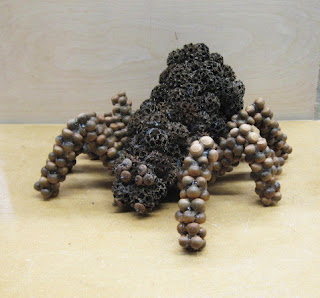Today's Class- Today we started the next graded project of the semester, one that looks back to the beginnings of 3D art. I showed an assortment of slides (supplemented with images in print) of ancient 3D stone age art. Common characteristics of this art include a use of natural materials available to the people of that era, low technology, subjects based on living things (such as humans, animals, and imaginary beings), and visual approaches often related to the materials. So I decided we should take on this idea ourselves. The assignment is to create a three dimensional artwork that takes on a human/animal/hybrid subject and does it by using only natural materials.
We started with a simple exercise, taking a handful of sea shells and seeing what (if anything) the existing shapes there resembled. Nothing was permanently assembled at that point, but students did find patterns and shapes that could have been expanded into fish, flowers, human behaviors, etc. I made those shells available to the class, adding some cut pieces of bamboo from my residence, while some students had materials they had brought from home, such as sticks, pine cones, and rocks, and still more were foraged from the campus and surrounding woods. I set up the following rules:
1) Subjects would be the types of things favored by stone age artists- humans, animals, details of such things, and mythological beings.
2) Building materials should come directly from nature- nothing manufactured by modern processes. So wood can be from sticks and other collected materials, through milled natural woods, but no plywood or composite wood. Natural rock is acceptable, but no cement, asphalt, or bricks. Absolutely no synthetics (plastics, refined metals, etc). If it didn't exist in the stone age, we can't use it. Materials may be manipulated through physical means/tools, such as carving, or smashing to pieces.
3) One exception is that I will allow the use of hot glue as a means to attach stuff together, as well as other modern adhesives. Since stone age art was often painted, you may paint your objects in any way you want.
4) No specific size requirements.
5) It should resemble the thing it's meant to be, but they need not be perfect renditions of those things. For example, a horse wouldn't need to be an anatomically accurate rendition of a horse, but should be something that anyone would recognize as a horse.
Below are student examples from previous semesters-
And here are some from this semester:
Several members of the class still haven't turned in any of the major projects yet. Each week they are late, points are lost.
For next class 10/21/16- a portfolio exercise that relates to the idea of seeking inspiration in the shapes that exist in the world, as our stone are project does, and the recent skeleton relief sculpture project did. I had asked you to secure for yourself some pulp cardboard coffee trays of the type found most places coffee is sold as a take out item. Bring in three, plus a knife to cut them up, and glue.









No comments:
Post a Comment
Note: Only a member of this blog may post a comment.